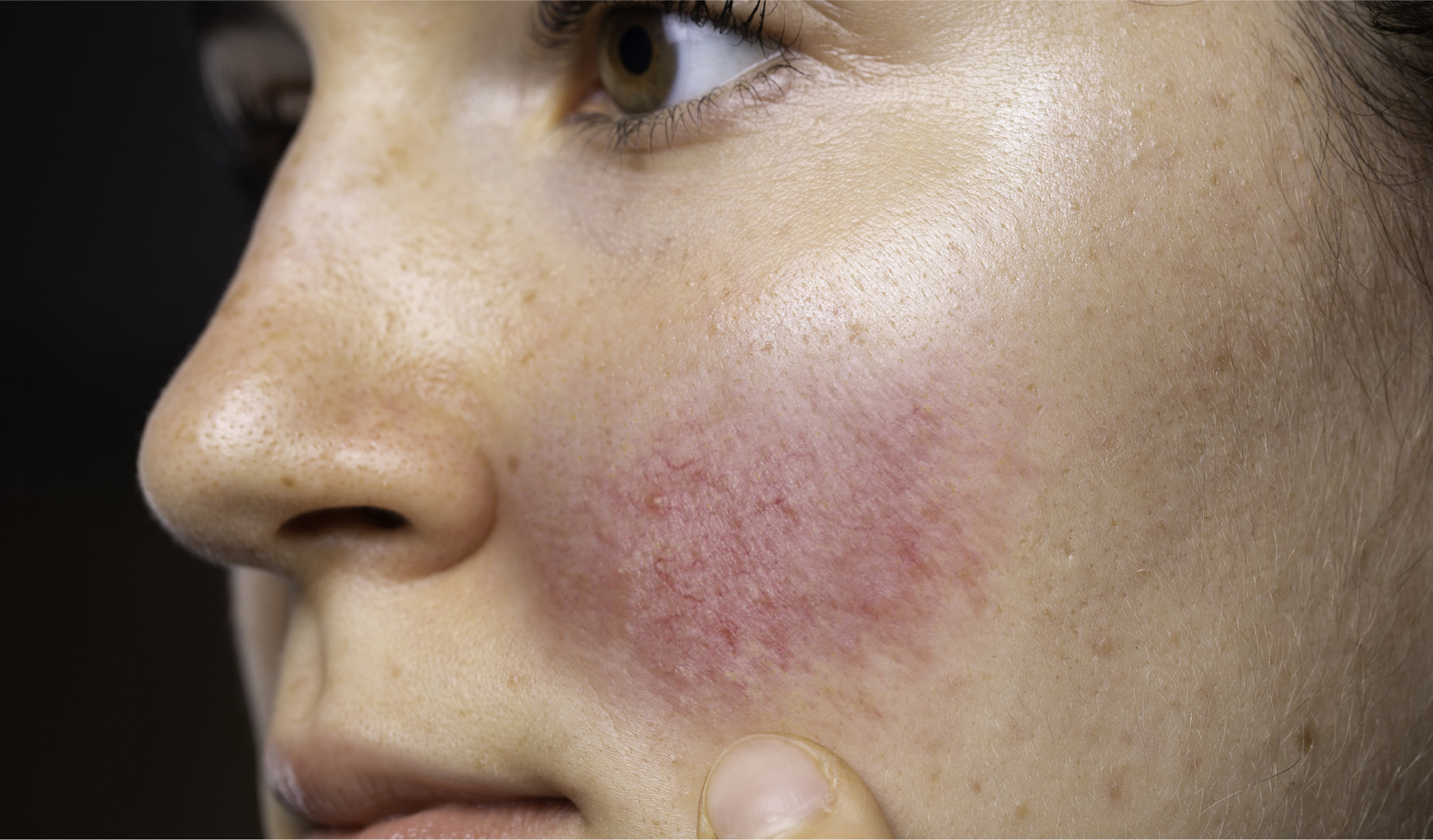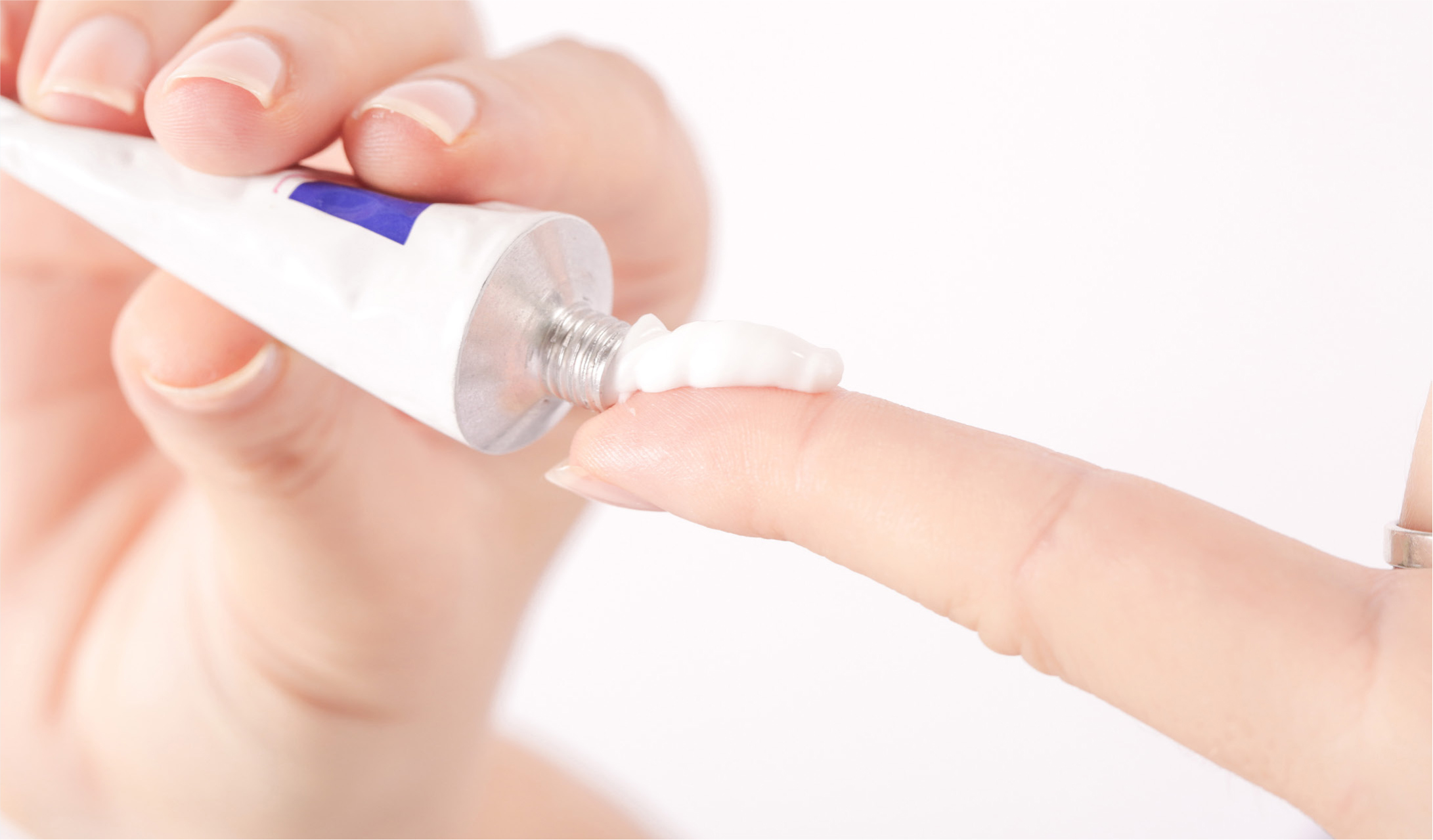
Rosacea is a common chronic skin condition that affects the face. It is most common in fair-haired, blue-eyed people, and affects approximately 5% of the world's population (Gether et al, 2018). There is a bimodal prevalence, with the main peak occurring between the ages of 40–50 years.
Clinical features
Diagnosis of rosacea can be difficult at times. The rash in this condition is central on the face, sparing the periorbital and perioral region.
There is:
- Erythema, which is initially intermittent, then constant
- Telangiectasia
- Pustules and papules
- Thickening of the skin
- No open comedones.
Other features include rhinophyma, which is marked thickening of the nose skin, and ocular involvement in 50% of cases, which includes conjunctivitis, blepharitis, chalazion and episcleritis. There may even be iritis and keratitis.
Features that might aid diagnosis include:
- History of previous episodic flushing
- Erythema that is described as burning or stinging.
The following can aggravate the symptoms of rosacea:
- Anything that can cause flushing, including caffeine, spicy food, alcohol and sunlight
- Vasodilator medication
- Topical steroids.
Differential diagnosis
Other conditions that may be confused with rosacea include:
- Acne vulgaris: has comedones, but no flushing or telangiectasia
- Seborrhoea: tends to affect the scalp and piriform fossa and there is usually scale
- Contact dermatitis: itchy scaly erythematous rash, but the distribution is often different
- Photodamage: generalised erythema, some scaly and mottled areas, occurs in sun-exposed areas
- Perioral/periocular dermatitis: this mainly affects young women and features a papular rash around the eyes or mouth, but there is no telangiectasia.
Diagnosis can still be difficult, and conditions can co-exist. Sometimes a biopsy is necessary for diagnosis.
Diagnostic schema
In 2017, Tan et al endorsed a consensus of diagnostic criteria, constructed by a panel of international experts from ROSacea COnsensus (ROSCO). It is considered to be a useful diagnostic schema.
Aetiology of rosacea
There is a genetic predisposition to rosacea (Abram et al, 2010). Furthermore, in twin studies, Aldrich et al (2015) suggested that there is a 46% genetic contribution. However, it is not clear exactly how these genetic factors operate.

The aetiology of rosacea remains unclear, but it appears to be multifactorial with a genetic predisposition. Steinhoff et al (2016) suggested that there are multiple triggers that lead to an innate immune response or a vascular dysregulation. The exact mechanisms remain contentious. Cathelicidins, which are part of the body's antimicrobial defence system, are found in high concentrations in rosacea patients (Yamasaki et al, 2007). Matrix metalloproteins (MMP) such as collagenase and elastase appear important and are found in high concentrations in the thickened skin of rosacea.
Lastly, Demodex folliculorum, a mite that is found in increased quantities in rosacea papules, is thought to be a secondary event due to inflammation (Forton, 2020).
Management
Rosacea used to be treated with bloodletting, but, fortunately, management of this condition has improved. It is based on symptom suppression to prevent progression and sustain remission. Reinholz et al (2016) suggested that management is individualised, but based on the following:
- Ensuring correct diagnosis
- Evaluating exacerbating factors
- Looking for co-morbidities/risk factors
- Discussing quality of life and/or self-esteem issues
- Recognition that this is a chronic disease that needs lifelong treatment
- Trigger factors should be avoided, a gentle skin regime incorporated and sun protection factor (SPF) used
- Discussing treatment options.
Gentle skincare
Generally, patients with rosacea require a gentle skincare regime based on an emollient that is applied and allowed to soak in, an SPF 30 sunblock and a gentle low soap (<10%) cleanser.
Wang et al (2020) found an increased incidence of rosacea in people who cleansed their faces frequently and expansively.
Guertler et al (2020) showed that an 8-week course of micellar water, serum and cream significantly reduced facial redness in rosacea patients, while Santoro et al (2019) suggested that a regime aimed at improving skin hydration and sunscreen use is effective in those with rosacea, with over 90% of participants wishing to continue the regime.

However, there are no controlled studies on which regime is best for rosacea. Makeup can be used, but carefully, as minimal makeup tends to be less irritating.
Topical agents
For mild to moderate rosacea, topical therapies are considered to be first-line treatments (Elewski et al, 2011). Topical metronidazole 0.75–1% and azelaic acid 15% are well tolerated and effective (Thiboutot et al, 2003). Ivermectin 1% appears slightly more effective in papulopustular rosacea (Taieb et al, 2015). Sodium sulfacetamide is a sulphur-based product effective in mild to moderate rosacea (Del Rosso, 2004) and is available over the counter in the UK.
The most common symptom of rosacea is transient or persistent erythema (Steinhoff et al, 2016) that diffuses and is in the centre of the face. Del Rosso (2012) concluded that topical metronidazole and azelaic acid were ineffective in treating erythema, especially if it was persistent.
Brimonidine tartrate 0.33% gel has been used for the flushing aspect of rosacea. It has shown up to a 50% improvement and is well tolerated (van Zuuren et al, 2015). There are side effects (mainly rebound erythema) in approximately 20% of patients (Ilkovitch et al, 2014). One study by van Zuuren (2017) found an additive effect of brimonidine gel with ivermectin 1% cream.
Fowler et al (2013) described the optimal use of brimonidine 0.5% gel, which is best used twice daily, as its effects begin after 30 minutes and decrease after about 9 hours. The study found the product safe and with minimal side effects, including the incidence of tachyphylaxis. In day-to-day use, the issues with worsening erythema were transient, and most patients found the product useful.
Oral treatment
Generally, tetracyclines are considered useful and effective in treating rosacea, and 40mg doxycycline is effective as 100mg with lower side effects, particularly on vaginal flora (van Zuuren, 2015). In the UK, lymecycline is often used. Additionally, clarithromycin or erythromycin can be used in refractory cases or those intolerant of tetracyclines (Rivero and Whitfeld, 2018). In one study, taking clarithromycin for 6 weeks appeared to be as effective as 8 weeks of doxycycline 40mg (Valentín et al, 2009). Judged on effectiveness, courses of 8–16 weeks seem to be the consensus. Bikowski (2003) noted an 80–100% clearing of inflammatory lesions and a 50% reduction in erythema after 4 weeks with 40mg doxycycline per day. Furthermore, 50mg doxycycline is cheaper and more readily available, so is most likely a reasonable alternative.
» The management of rosacea is like that of any chronic disease: considering the patient's feelings and understanding of the disease and helping to inform a treatment plan «
Oral isotretinoin at low doses (0.25mg/kg) is helpful in recalcitrant rosacea. Sbidian et al (2016) found 4 months of treatment to be effective. 50% relapsed after a median time of 15 weeks, suggesting further courses might be useful. The dosing required to maintain effect has yet to be fully determined.
Light-based treatments
Lasers and intense pulsed light (IPL) are useful in treating the erythema of rosacea. Handler et al (2017) found both IPL filtered at 560nm and pulse dye laser 595nm equally effective at treating symptoms. Alam et al (2013) found both 1064nm Nd:YAG and 595nm pulse dye laser effective for erythematous rosacea, but the latter was less painful and slightly more effective. Uebelhoer et al (2007) found the 532nm potassium-titanyl-phosphate laser to be as effective as the 595nm pulse dye laser.
It appears that a range of devices are effective at treating both the telangiectasia and erythema of rosacea.
In rhinophyma, a late-stage rosacea, there are significant changes to the nasal soft tissue, which leads to thickening and a bulbous appearance. In such cases, ablative lasers, such as CO2 or Er:YAG, are employed and show good results (Bassi et al, 2016). Another option is surgery, sometimes using the heated Shaw scalpel (Stucker et al, 2003), which also appears to have satisfactory results.
Light-emitting diode (LED) treatments may help to reduce inflammation in rosacea, but the author could not find many case studies (Sorbellini et al, 2020). There appears to be no reason why it should not be employed, although its effect should not be overstated.
Botulinum toxin
Kim et al (2019) showed that intradermal botulinum toxin is effective at treating erythema, telangiectasia and flushing in rosacea patients. There are several small studies supporting this where doses vary. Generally, the dosing is 1–2 IU intradermally per cm2 of botulinum toxin, with improvement times between 2 weeks and 3 months. More studies are required to determine optimal regimes.
Conclusion
Rosacea is a common chronic condition that severely affects the life of patients. Diagnosis is important, which is why medical aesthetic practitioners must ensure that a firm diagnosis has been made, preferably by a dermatologist, before commencing treatment. The rise of ‘skin experts’ with no formal dermatological training who are providing advice on social media sites is concerning.
The management of rosacea is like that of any chronic disease: considering the patient's feelings and understanding of the disease and helping to inform a treatment plan. Many treatments are available via the NHS, but some are inaccessible or difficult to obtain. Similarly, many rosacea patients are not aware of the potential treatment options available, and some clinicians are not experienced in treating the condition, so may not understand its implications. As rosacea is a challenging chronic condition, some patients will feel dissatisfied with their experience, which often triggers contact with an aesthetic clinic. The use of positive statements, while underpromising and overdelivering, seems to be a sensible approach.
Treatment depends on the type of rosacea, but a regime of good skincare, including SPF, emollients and gentle skin cleanser, trigger avoidance, ivermectin 1% cream and doxycycline 50mg for 8 weeks is often a good starting point, although variations on this theme are also acceptable.
Key points
- Rosacea is a fairly common condition, especially in fair-haired, blue-eyed people
- It is a chronic condition that requires correct diagnosis and careful management to achieve optimal results
- To ensure a correct diagnosis, this should be made by a dermatologist before treatment is commenced
- Topical agents and oral antibiotics play a role in treating rosacea
- Laser or intense pulsed light can treat the telangectasia that is often present.
CPD reflective questions
- Is azelaic acid cream effective in persistent erythema of rosacea?
- Is botulinum toxin useful in the treatment of rosacea?
- Are open comedones a key feature of rosacea?



